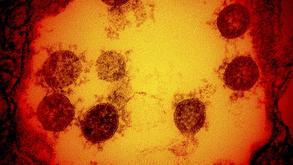22 scientists conclude in global paper that virus likely crossed from animals
 This undated handout image obtained July 15, 2020, courtesy of National Institute of Allergy and Infectious Diseases(NIH/NIAID), shows a transmission electron micrograph of SARS-CoV-2 virus particles, isolated from a patient, captured and color-enhanced at the NIAID Integrated Research Facility (IRF) in Fort Detrick, Maryland. (Handout / National Institute of Allergy and Infectious Diseases / AFP)
This undated handout image obtained July 15, 2020, courtesy of National Institute of Allergy and Infectious Diseases(NIH/NIAID), shows a transmission electron micrograph of SARS-CoV-2 virus particles, isolated from a patient, captured and color-enhanced at the NIAID Integrated Research Facility (IRF) in Fort Detrick, Maryland. (Handout / National Institute of Allergy and Infectious Diseases / AFP)
The virus that caused the COVID-19 pandemic almost certainly originated from a wild animal and not from a laboratory leak, according to a report from nearly two dozen leading virus experts from around the globe.
Among the 22 contributors to the report is Stephen Goldstein, an evolutionary biologist at the University of Utah in Salt Lake City. Their paper, "The Origins of SARS-CoV-2: A Critical Review", was published in early July.
It concluded: "The documented epidemiological history of the virus is comparable to previous animal market-associated outbreaks of coronaviruses with a simple route for human exposure."
The authors of the review, led by Edward Holmes from the University of Sydney, are scientists from universities and research institutes in countries including the United States, the United Kingdom, New Zealand, Austria, Australia and China.
Goldstein, in elaborating on the findings, told the Salt Lake Tribune newspaper: "If you look at where the first cases in Wuhan were, there's a really striking concentration of those cases starting in the neighborhoods surrounding this market (Huanan Seafood Wholesale Market) and spreading outward from there.
"Similarly, the excess deaths observed in Wuhan begin in the part of the city that includes that market and then spread to other parts of the city."
Besides the geographic evidence, Goldstein said that those markets were selling animals that are susceptible to carrying the virus.
The review refutes the claims in theories advanced by some that the virus that causes COVID-19 likely originated from an engineered coronavirus that escaped from the Wuhan Institute of Virology, or WIV.
"There is no evidence that any early cases had any connection to the WIV, in contrast to the clear epidemiological links to animal markets in Wuhan, nor evidence that the WIV possessed or worked on a progenitor of SARS-CoV-2 prior to the pandemic," stated the review, in referring to the name of the virus. "The suspicion that SARS-CoV-2 might have a laboratory origin stems from the coincidence that it was first detected in a city that houses a major virological laboratory that studies coronaviruses."
Goldstein drew the same conclusion. "There's no real reason to put any weight on the possibility of a lab leak right now. We've got nothing that points to the lab other than suspicion and innuendo based on the idea of not trusting China," he said.
Objective examination
Goldstein thinks that objective examination is important for preventing future outbreaks.
"If we don't figure out how this happened and generate the political will to eliminate the situations that allow it to happen, then it's going to keep happening," he said.
Commenting on the review, Jonathan Stoye, group leader of Retrovirus-Host Interactions Laboratory at the Francis Crick Institute in the UK, said the lab-leak theories "remain essentially speculative, at times verging on conspiratorial".
Stoye said: "The current preprint provides a refreshingly clear and reasoned description of the virological events that have taken place during the emergence of the pandemic virus. It makes a strong case for the natural origin of the virus followed by ongoing adaptation in humans.
"The continuing evolution of the virus to give new variants, highlighted by the independent acquisition of the N501V change on multiple occasions, is clearly inconsistent with the notion of a purposely manipulated virus optimized for growth on human cells."


